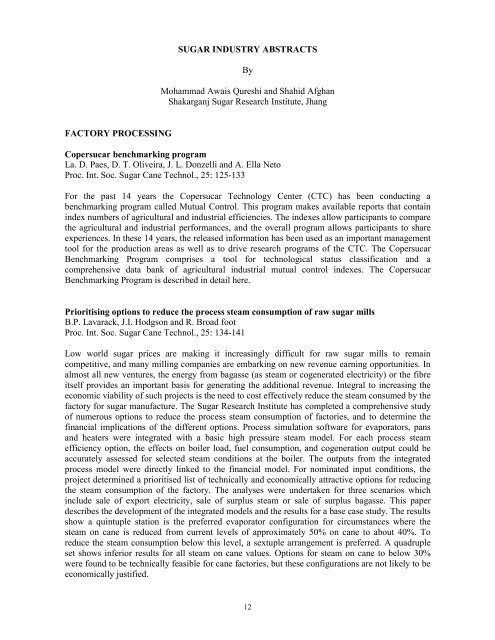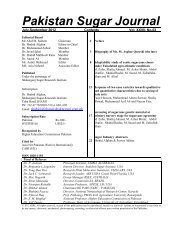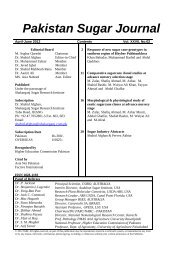Sep to Oct 2006 - Shakarganj
Sep to Oct 2006 - Shakarganj
Sep to Oct 2006 - Shakarganj
You also want an ePaper? Increase the reach of your titles
YUMPU automatically turns print PDFs into web optimized ePapers that Google loves.
FACTORY PROCESSING<br />
SUGAR INDUSTRY ABSTRACTS<br />
By<br />
Mohammad Awais Qureshi and Shahid Afghan<br />
<strong>Shakarganj</strong> Sugar Research Institute, Jhang<br />
Copersucar benchmarking program<br />
La. D. Paes, D. T. Oliveira, J. L. Donzelli and A. Ella Ne<strong>to</strong><br />
Proc. Int. Soc. Sugar Cane Technol., 25: 125-133<br />
For the past 14 years the Copersucar Technology Center (CTC) has been conducting a<br />
benchmarking program called Mutual Control. This program makes available reports that contain<br />
index numbers of agricultural and industrial efficiencies. The indexes allow participants <strong>to</strong> compare<br />
the agricultural and industrial performances, and the overall program allows participants <strong>to</strong> share<br />
experiences. In these 14 years, the released information has been used as an important management<br />
<strong>to</strong>ol for the production areas as well as <strong>to</strong> drive research programs of the CTC. The Copersucar<br />
Benchmarking Program comprises a <strong>to</strong>ol for technological status classification and a<br />
comprehensive data bank of agricultural industrial mutual control indexes. The Copersucar<br />
Benchmarking Program is described in detail here.<br />
Prioritising options <strong>to</strong> reduce the process steam consumption of raw sugar mills<br />
B.P. Lavarack, J.I. Hodgson and R. Broad foot<br />
Proc. Int. Soc. Sugar Cane Technol., 25: 134-141<br />
Low world sugar prices are making it increasingly difficult for raw sugar mills <strong>to</strong> remain<br />
competitive, and many milling companies are embarking on new revenue earning opportunities. In<br />
almost all new ventures, the energy from bagasse (as steam or cogenerated electricity) or the fibre<br />
itself provides an important basis for generating the additional revenue. Integral <strong>to</strong> increasing the<br />
economic viability of such projects is the need <strong>to</strong> cost effectively reduce the steam consumed by the<br />
fac<strong>to</strong>ry for sugar manufacture. The Sugar Research Institute has completed a comprehensive study<br />
of numerous options <strong>to</strong> reduce the process steam consumption of fac<strong>to</strong>ries, and <strong>to</strong> determine the<br />
financial implications of the different options. Process simulation software for evapora<strong>to</strong>rs, pans<br />
and heaters were integrated with a basic high pressure steam model. For each process steam<br />
efficiency option, the effects on boiler load, fuel consumption, and cogeneration output could be<br />
accurately assessed for selected steam conditions at the boiler. The outputs from the integrated<br />
process model were directly linked <strong>to</strong> the financial model. For nominated input conditions, the<br />
project determined a prioritised list of technically and economically attractive options for reducing<br />
the steam consumption of the fac<strong>to</strong>ry. The analyses were undertaken for three scenarios which<br />
include sale of export electricity, sale of surplus steam or sale of surplus bagasse. This paper<br />
describes the development of the integrated models and the results for a base case study. The results<br />
show a quintuple station is the preferred evapora<strong>to</strong>r configuration for circumstances where the<br />
steam on cane is reduced from current levels of approximately 50% on cane <strong>to</strong> about 40%. To<br />
reduce the steam consumption below this level, a sextuple arrangement is preferred. A quadruple<br />
set shows inferior results for all steam on cane values. Options for steam on cane <strong>to</strong> below 30%<br />
were found <strong>to</strong> be technically feasible for cane fac<strong>to</strong>ries, but these configurations are not likely <strong>to</strong> be<br />
economically justified.<br />
12






